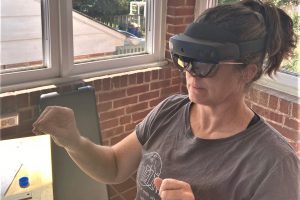
Six months of pandemic-caused remote teaching and learning challenged both students and professors to get creative to make sure that educational objectives were met. So during the fall semester, Orla Wilson, associate teaching professor in materials science and engineering, used a futuristic tool to put her students in the lab virtually, all from the comfort of their own homes.
HoloLens is a mixed reality platform made by Microsoft which allows the user, wearing the iconic smartglasses, to create a 3D environment featuring holograms, geotags, live menu systems and more. The user wearing the headset can see these things seemingly floating around them in any room or space, and can grab, resize, and manipulate the items in real time using their hands. Mixed reality technology is currently being used in fields from healthcare to entertainment; popular furniture stores, for instance, offer apps that let potential customers see how a specific chair or table will look in their own living rooms.
Because the HoloLens lets both physical and virtual objects interact in real time, it seemed to Wilson to be the perfect way to allow students to explore lab equipment that they could not interact with in person due to social distancing safety measures. Logging in from home, it allowed Materials Science Lab class students to learn about physical equipment such as the SEM while getting live information from interactive virtual labels. Ese Bowry, a third-year MSE major and computer-integrated surgery minor, helped Wilson and the team develop programming for the platform to make this happen sometime in the ’20-’21 academic year.
As students returned to campus this semester, Wilson hopes to send one student per each lab group into the lab and equipped with the HoloLens, so they can complete the lab assignment with their group members tuned in at home to help guide them.
“I know I was tired of watching pre-recorded instructional videos,” said Wilson, “I just want to give the students as real and engaging an experience as possible.”
The HoloLens technology was acquired with funds from the 2020 Digital Education & Learning Technology Acceleration (DELTA) Grants. 2020 marks the third year of the DELTA grant program, a university-wide funding initiative through the Office of the Provost to supply classrooms and faculty with new and much needed digital technology and anyone can apply. Principal investigators including Wilson, Luo Gu, Patty McGuiggan, and Sakul Ratanalert of the Whiting School of Engineering, and Robert Leheny and Meredith Safford of the Krieger School of Arts and Sciences, were recognized with the award and are working on how they will incorporate the technology over the next few years.
“It’s fun to learn something new along with the students,” said Wilson. “We’re all having to adapt and get a little awkward to do the best we can learning from home.”
Spring Semester Update:
This spring semester, Wilson is looking for opportunities for students to wear the devices in the lab for collaboration and “mission control” type work. Although all students will not be permitted in the lab at one time, she wants to bring them together from various socially distanced learning locations (i.e. a conference room, or biomaterials lab).
“This way, everyone will be able to see what’s happening from the perspective of their teammate wearing the HoloLens device,” says Wilson.
Bowry says bringing a student’s perspective to her classmates has been a new element this time around.
“Last semester, we got to see the lab from the professor’s perspective with the livestream function. Now, students will be wearing the HoloLens themselves and broadcasting to fellow lab partners,” Bowry says. “It should be a much more interactive experience.”
Wilson says that other departments are exploring the way of this technology, too. She and Bowry think this new, innovative and engaging form of learning is here to stay.
“It proved useful during completely virtual semesters,’ said Bowry “but I think it’s the future of the classroom experience.”